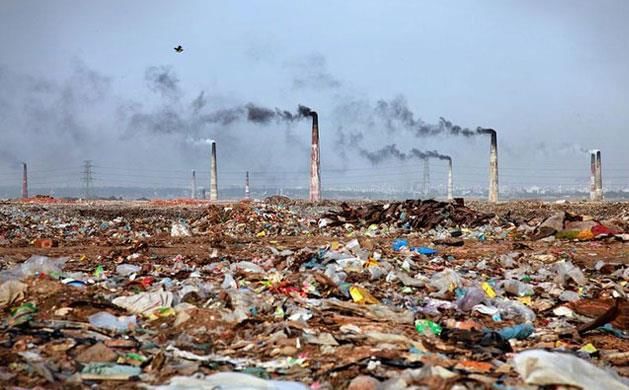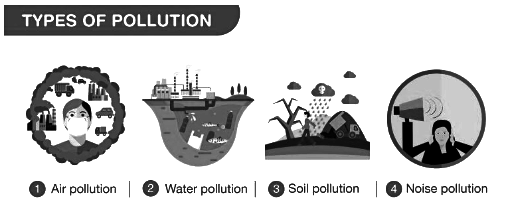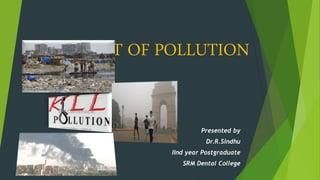Revision Notes: Pollution - A Rising Environmental Problem | Biology Class 10 ICSE PDF Download
| Table of contents |

|
| Pollution |

|
| Nature of Pollutants |

|
| Different Kinds of Pollution |

|
| Abatement of Pollution |

|
| Vehicular Standards |

|
| Clean India Movement |

|
Pollution

Pollution refers to the introduction of any substance into the environment that leads to its deterioration or contamination, making it less suitable for living organisms. A substance that causes pollution is called a pollutant.
Nature of Pollutants

1. Biodegradable Pollutants
- Biodegradable pollutants consist of organic matter that can be decomposed by the activity of microorganisms.
- These pollutants can be recycled either naturally or by humans.
- After biodegradation, useful products can be produced from these materials.
- Examples of biodegradable pollutants include paper, cow-dung, and vegetable peels.
2. Non-biodegradable Pollutants
- Non-biodegradable pollutants are made up of inorganic matter, and they do not decompose.
- These pollutants cannot be recycled naturally.
- They remain unchanged in the environment, or if they undergo chemical reactions, the products of these reactions are also non-biodegradable.
- Examples of non-biodegradable pollutants include DDT, synthetic fibres, plastic, metals, and Styrofoam.
Different Kinds of Pollution

Air Pollution
Sources of Air Pollution
- Natural: Ash, Dust, Forest Fires
- Man-made: Exhaust from vehicles, Pesticides, Insecticides, Radioactive Substances
Types of Air Pollution
- Gaseous Pollution: Emission of harmful gases from various sources.
- Particulate Pollution: Involves particles of dust, smoke, and debris from activities such as mining, stone drilling, and the wearing of rubber tires from vehicles.
Major Gaseous Pollutants
1. Carbon Monoxide (CO)
- Sources: Emitted from vehicle exhaust and the burning of agricultural waste, dry leaves, and various domestic and industrial waste.
- Harmful Effects: CO binds with hemoglobin in the blood to form carboxyhemoglobin, an irreversible compound. This process inhibits the circulation of oxygen in the blood, leading to health issues such as headaches, nausea, and anemia. Prolonged exposure to CO can be fatal.
2. Nitrogen Dioxide (NO2)
- Sources: Produced by lightning and high temperatures in automobile engine combustion chambers.
- Harmful Effects: NO2 irritates the eyes and contributes to the formation of acid rain.
3. Sulphur Dioxide (SO2) and Sulphur Trioxide (SO3)
- Sources: Emitted from the burning of fossil fuels and the heating of sulphide ores in excess air.
- Harmful Effects: These substances contribute to the formation of smog. High concentrations can lead to severe respiratory issues and can be fatal.
4. Hydrogen Sulphide (H2S)
- Sources: Released during the burning of coal, in petrol refineries, and from volcanic eruptions.
- Harmful Effects: H2S exposure can cause nausea, sore throat, and eye irritation.
Effects of Air Pollution
1. Acid Rain
- Sulphur dioxide and nitrogen dioxide mix with moisture in the clouds, forming sulphuric acid and nitric acid.
- These acids are then released to the ground with rainwater.
- This phenomenon leads to the corrosion of monuments, such as the Taj Mahal in India.
2. Smog
- Smog is a combination of fog, dust, smoke, and sulphur dioxide.
- It is commonly seen in populated and industrial areas during winter mornings.
- The reduced visibility caused by smog can result in road and rail accidents.
3. Greenhouse Effect and Global Warming
- A greenhouse is a small glass structure that allows sunlight to enter while trapping heat inside, facilitating plant growth.
- In a similar way, certain gases in the atmosphere, like carbon dioxide (CO2), methane, nitric oxide, and nitrous oxide, trap heat and prevent it from escaping.
- The increased concentration of these greenhouse gases leads to the warming of the atmosphere.
- This phenomenon, known as global warming, results in the melting of snow caps, rising sea levels, decreased agricultural productivity, and the extinction of species such as polar bears.
4. Ozone Depletion
- Ozone plays a crucial role in protecting life on Earth by absorbing harmful ultraviolet (UV) rays from the Sun.
- However, certain compounds like chlorofluorocarbons (CFCs) contribute to the depletion of ozone in the atmosphere.
- When ozone levels decrease, more UV rays penetrate the Earth’s surface, leading to health issues such as sunburns, skin cancer, and genetic mutations.
- To raise awareness about ozone depletion, 16 September is celebrated as International Ozone Day.
5. Health Problems
- Oxides of nitrogen and sulphur: Cause eye irritation.
- Hydrogen sulphide: Leads to respiratory disorders, bronchitis, and asthma.
- Particulate matter: Triggers asthma.
- Carbon monoxide: Results in headaches, dizziness, nausea, and decreased oxygen-carrying capacity of blood.
- Heavy metals: Cause liver, kidney, and brain damage, as well as abnormal fertility and pregnancy issues.
- Radioactive pollutants: Can lead to anaemia.
- Silica particles: Cause silicosis, a lung disease.
- Cotton fibres: Lead to byssinosis, a condition characterized by chronic cough, bronchitis, emphysema, and lung tissue damage.
- Asbestos particles: Cause asbestosis, an inflammation of the respiratory tract that can lead to cancer.
- Coal particles: Cause black lung disease, which destroys the lungs and can be fatal.
Euro/Bharat Norms
- Under the Euro/Bharat norms, specific regulations have been established regarding the emission levels from all automobiles.
Water Pollution
- Water pollution refers to any alteration in water quality that renders it unsuitable for use by humans and other living organisms.
Sources of Water Pollution
- Household Detergents
- Sewage
- Industrial Waste
- Oil Spills
- Thermal Pollution
Effects of Water Pollution
- Brain and nerve damage caused by industrial effluents.
- Waterborne diseases such as cholera, dysentery, and jaundice.
- Insect breeding in stagnant water leading to diseases like malaria, dengue, and yellow fever.
- Intestinal parasitism resulting in anemia and weakness.
- Eutrophication : The accumulation of nitrates and phosphates in water, promoting rapid algae growth, leading to the choking of water bodies.
- Biomagnification : The process by which harmful substances enter the food chain and concentrate in the bodies of living organisms at each trophic level.
Soil Pollution
Soil pollution refers to the contamination of soil by pollutants, resulting in reduced productivity.
Sources of Soil Pollution
- Chemical residues and fly ash
- Plastic bags and domestic waste
- Chemical fertilizers
- Biomedical waste such as syringes
- Pesticides like DDT
When soil loses its plant cover, it becomes susceptible to wind and rain, leading to rapid erosion.
Effects of Soil Pollution
- Soil pollution primarily decreases soil fertility.
- Fertilizers and pesticides used may enter the food chain, causing harm to organisms at each trophic level.
Radioactive Pollution
Radiation is a type of energy made up of high-energy particles. It can be harmful to living organisms when present in large amounts.
Sources of Radioactive Pollution
- X-rays: Used in medical imaging but can contribute to radiation exposure.
- Nuclear explosives: Release large amounts of radiation into the environment.
- Nuclear waste: Byproduct of nuclear reactors, containing harmful radioactive materials.
Types of Radiation
- Alpha Radiation (α): Penetrates the surface of the skin but is not as harmful externally.
- Beta Radiation (β): Emitted during nuclear tests and has greater penetrating strength than alpha radiation.
- Gamma Radiation (γ): Used in cancer treatment due to its strong penetrating power, but it is also the most harmful type of radiation.
Effects of Radioactive Pollution
- Harmful to living organisms: Radioactive rays can destroy living tissues and blood cells, affecting overall health.
- Disrupt cell functions: They can affect the functioning of the cell membrane and cell enzymes, leading to cellular dysfunction.
- Gene mutation: Radioactive pollution can cause changes in genes, leading to mutations.
- Cancer risk: Exposure to radioactive pollution can increase the risk of cancers, such as leukaemia.
- Foetal deformities: Pregnant individuals exposed to radioactive pollution may have an increased risk of having babies with deformities.
Noise Pollution
Noise is defined as any sound that is disturbing or unwanted. It can have various sources, both natural and artificial.
Sources of Noise Pollution
- Industrial machines: Equipment and machinery used in industries can produce loud and disturbing noises.
- Workshops: Places where various types of work are done, often involving loud tools and machines, contribute to noise pollution.
- Trains and automobiles: The sound of trains, buses, cars, and other vehicles adds to the overall noise levels in urban and suburban areas.
- Jet aircraft: The noise generated by aircraft during takeoff, landing, and flying contributes significantly to noise pollution, especially near airports.
- Loud conversations: People speaking loudly in public places can contribute to the overall noise level.
- Sounds of radio and television: Playing radios and televisions at high volumes, especially in public places, adds to noise pollution.
- Loudspeakers: Use of loudspeakers for announcements, music, or other purposes can create disturbing noise levels.
- Firecrackers: The sound produced by firecrackers, especially during festivals, contributes to noise pollution.
Effects of Noise Pollution
- Hearing Damage: Prolonged exposure to loud noise can harm the ears and lead to permanent hearing loss.
- Health Issues: Noise pollution is associated with high blood pressure, persistent headaches, and difficulty concentrating.
- Decreased Productivity: It disrupts thinking processes, resulting in lower efficiency at work.
- Sleep Disturbance: Noise pollution interferes with sleep, leading to irritability and nervous disorders.
Measures to Minimise Noise Pollution
- Horn Prohibition: Banning the use of vehicle horns.
- Loudspeaker Ban: Prohibiting the use of loudspeakers.
- Airport Location: Ensuring airports are situated away from residential areas.
- Firecracker Restraint: Encouraging people to refrain from lighting firecrackers.
Abatement of Pollution

- Clean Fuel Usage: Promoting the use of unleaded petrol and compressed natural gas (CNG) in vehicles to reduce emissions.
- Industrial Emission Control: Installing tall chimneys in factories equipped with filters and electrostatic precipitators to minimize airborne pollutants.
- Effluent Treatment: Treating industrial wastewater before discharging it into water bodies to prevent contamination.
- Recycling and Incineration: Recycling materials like plastic, glass, and metal, and incinerating non-recyclable waste to reduce landfill burden.
- Afforestation: Planting trees along roadsides and on mountain slopes to enhance soil stability and reduce erosion.
Vehicular Standards
- The Bharat norms, introduced in 2000, are emission control standards for vehicles and equipment using internal combustion engines. These norms are based on European regulations known as Euro norms.
- Over the years, the Bharat norms have been upgraded to BS II, BS III, and now BS IV, each setting stricter limits on the release of air pollutants.
- The Supreme Court of India has mandated that from April 1, 2017, only vehicles with engines compliant with BS IV standards can be sold.
Clean India Movement

The Swachh Bharat Abhiyan, launched on October 2, 2014, marks the 145th anniversary of Mahatma Gandhi's birth. It is a government-led initiative aimed at making India cleaner and eliminating open defecation.
The mission focuses on various targets, including:
- Converting insanitary toilets into pour-flush toilets
- Eradicating manual scavenging
- Ensuring complete disposal and reuse of solid and liquid waste
|
55 videos|110 docs|21 tests
|
FAQs on Revision Notes: Pollution - A Rising Environmental Problem - Biology Class 10 ICSE
| 1. What are the major types of air pollution? |  |
| 2. What are some common sources of water pollution? |  |
| 3. What are the effects of air pollution on human health? |  |
| 4. How does soil pollution occur, and what are its sources? |  |
| 5. What are the long-term effects of water pollution on the environment? |  |















